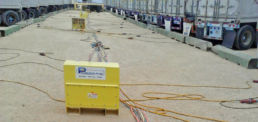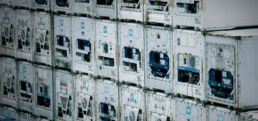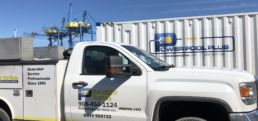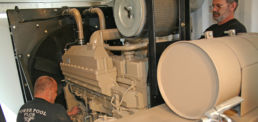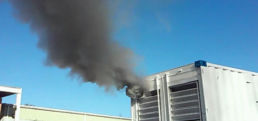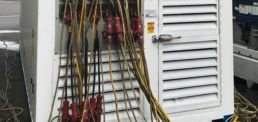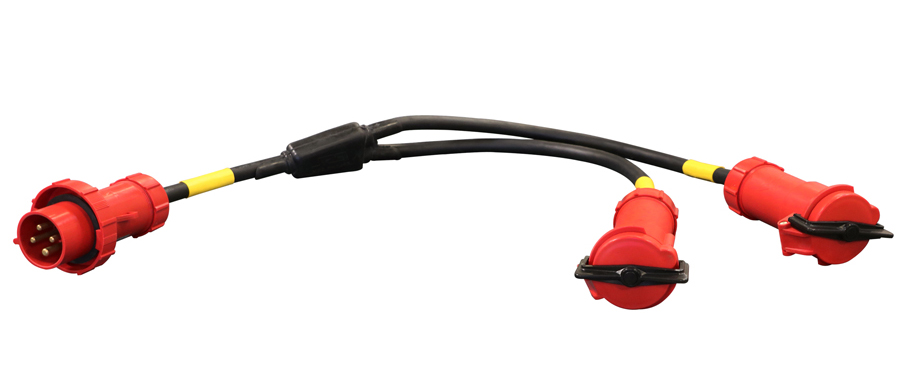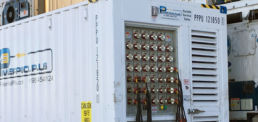Know when to replace your power cables
Check your power cables for safety and functionality
Without quality power cables to transfer electricity from the power pack generator to reefer racks or remote receptacle trees, keeping a reefer yard filled with refrigerated containers would be impossible.
Yet even the best-made cables require proper maintenance to ensure functionality and worker safety.
The ground cabling we use is dual-jacketed to protect the inner copper strands from damage. Yet, the constant dragging of cables across asphalt and gravel yards can take its toll.
Using color-contrasting layers provides a visual indicator. For example, when the outer jacket is worn through, cut, or scraped, the inner jacket reveals a distinctly white visual warning that it may be time to replace the cable.
This visual awareness provides easy identification of abrasion before reaching the copper stranding to ensure the safety of the operators.
See the image below provided by our friends at Trystar cable, which highlights the dual-jacket layers.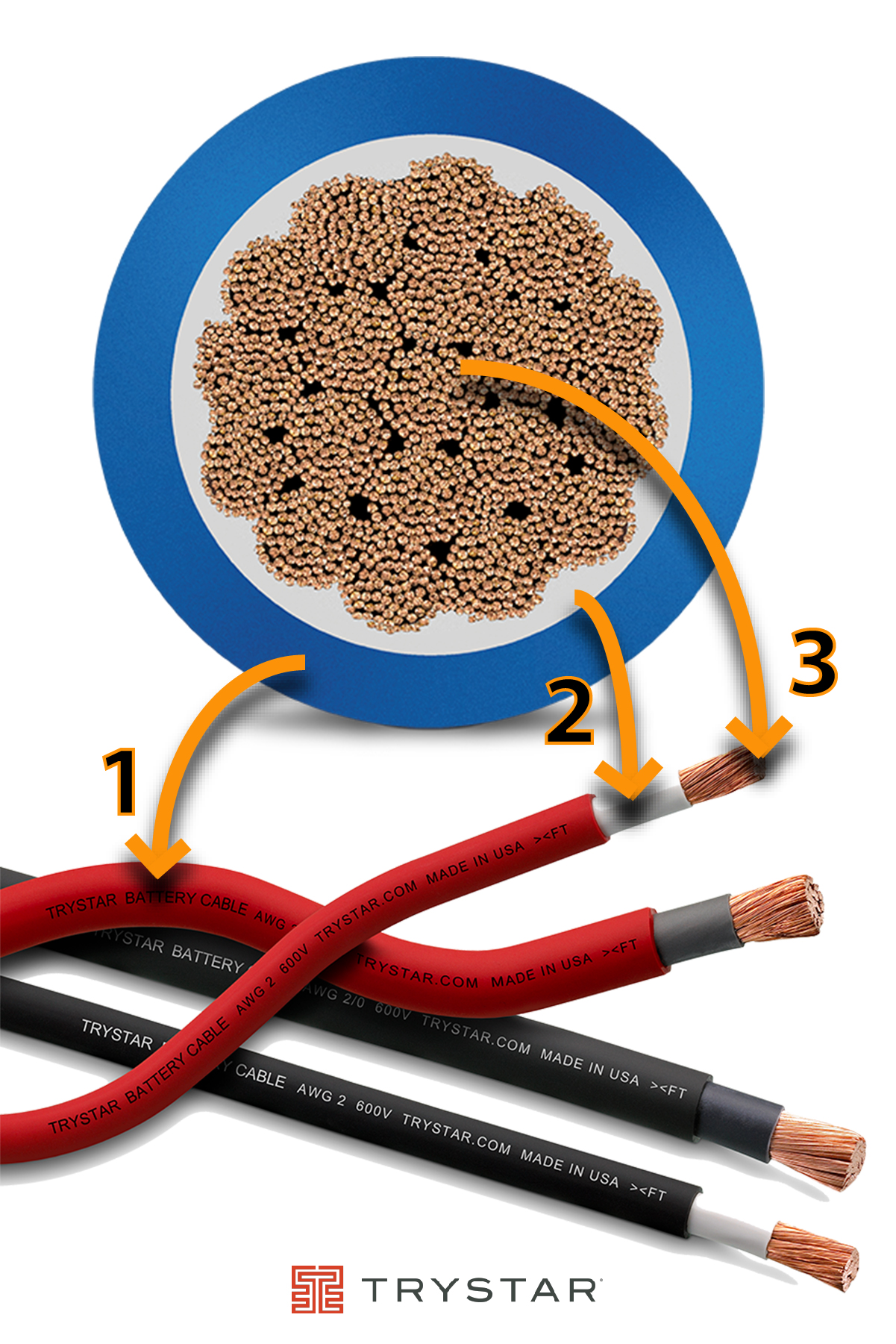
- Outer Jacket
- Inner Jacket
- Copper strands
A best practice when handling ground cables is to pick them up and move them into position to avoid unnecessary scuffs. Protect them from moving vehicle traffic, do not allow them to lay in pooling water, and inspect them frequently for damage.
Get a quote today, on your next Purpose-Built Power Pack.
Ted Shelson
VP Marketing
Power Pool Plus
How we're meeting today's supply chain challenges
An unprecedented challenge.
COVID shutdowns and lost labor time, shipping delays, crippling storms, and raw material shortages - Nearly all suppliers and end-users are experiencing challenges due to the inability to secure the parts and materials needed for timely production.
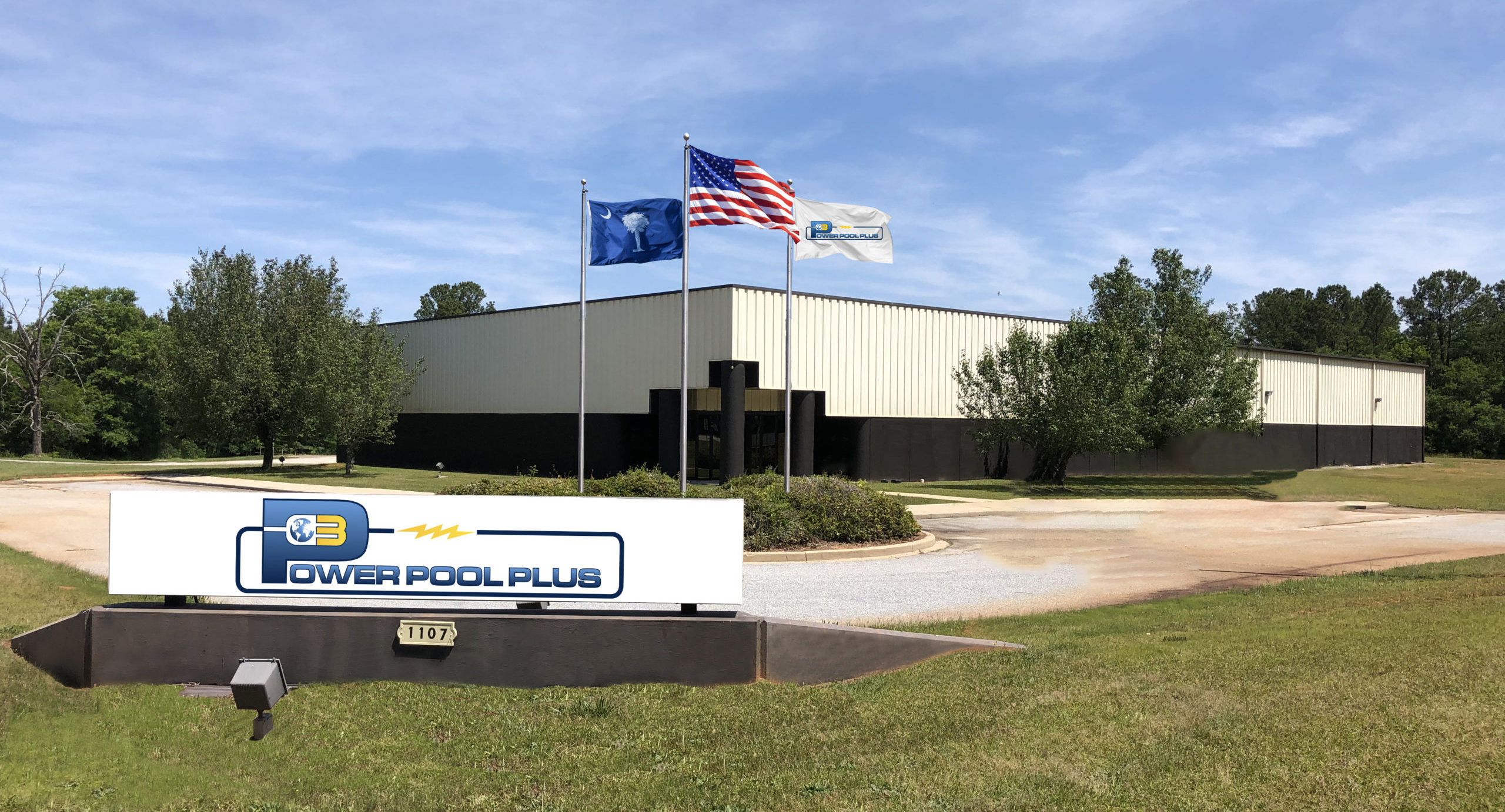
Power Pool Plus is no exception.
Even with the increased manufacturing capacity from our newly opened Greenwood, South Carolina plant, which affords us an additional 30,000sqft on 12+ acres of manufacturing space, delays in receiving raw materials for production prove problematic and negate any impact from this infrastructure investment.
For example, steel and electrical cable, two of the most used materials in our Power Packs, usually promised from our vendors in a few days, is now turning into 6-8 weeks or more. Our challenges are their challenges, as they count on commitments from their suppliers to turn products. It’s a vicious cycle.
According to a recent Wall Street Journal Report, up to 40 vessels anchored off Southern California ports had been waiting for dock space, which has since ebbed to around 17 earlier this week. While that is still too large a number, the backlog continues to shrink as ports and trucking catch up with the increased volumes.
But still, we are finding various steel products disappearing off our vendors’ shelves. And the availability of 20 and 40-ft high cube containers is also difficult to find at once typical prices. We continue to order in higher quantities than usual to stay ahead, so we have inventory to keep up with the demand.
While inflation has primarily been kept in check, there is talk about possible increases later in the year.
The good news is (there's always some good news),
as the world awakens from its COVID-induced sleep, it is clear that the demand for goods is strong. Consumers are looking to buy, and industries are ready to make investments to meet the demand. Refrigerated transport is no exception. As the demand for fresh produce increases, the need for power at ports to manage reefer throughput will remain high.
Our power packs are needed, orders are up, and accordingly, we have made investments in our production facilities to stay ahead.
So be patient. These delays will pass, and a sense of normalcy will resume. Until then, please know that all of us at Power Pool Plus are working hard to provide you with the finest Purpose-Built Reefer Power Genset on the market while remaining at a reasonable price to help your operation succeed.
Suppose your reefer management team is looking to increase productivity this year with new Power Pool Plus power packs. In that case, we highly suggest placing orders as soon as possible to minimize potential delays and expected increases in material costs.
Get a quote today, on your next Purpose-Built Power Pack.
Ted Shelson
VP Marketing
Power Pool Plus
A Perfect Storm flooding reefer terminals (and it's not water)
With the ever-increasing demand for year-round fresh fruits and vegetables, refrigerated containers full of perishable produce are hitting US ports at staggering rates. The need for ports to accept these reefers is demanding. But will this flood of reefers swamp terminal operators?
Why are refrigerated containers stuck in port?
In some cases, container ships arrive into port with more reefer to off-load than initially forecast, putting an incredible strain on the port operator to round up enough reefer receptacles for a load of containers.
Under normal times this may not be a problem. But these are not normal times.
Increased refrigerated container traffic combined with multiple ships arriving back-to-back allows little time for some port operators to move reefer off the terminal before the next ship arrives. Compounding these challenges is the decreased availability of truckers due to COVID. Without truckers to haul this cargo, everything sits - preventing terminal operators from moving reefer out of the port quickly.
But unlike dry containers that can be stacked and positioned just about anywhere in the yard, refrigerated containers require a constant supply of electricity to keep the perishable goods within temperature specs. Every reefer unloaded onto the terminal needs to quickly find an available electrical connection. The financial risk of cargo spoilage is real and is a challenging responsibility for port operators.
Here's a solution.
Ideally, moving these perishable loads out of the port as quickly as possible is the best solution. But when that's not an option, diesel-powered generators, called Power Packs, offer port operators the flexibility to ramp up reefer capacity quickly to handle sudden increases in container throughput. Power Packs uniquely accommodate thirty to fifty or more reefer cord connections. And because they are diesel-powered, they can be positioned anywhere space is available.
- Through short term rentals, terminal operators can quickly add capacity during traditional spikes in reefer throughput.
- Longer rental terms can help operators mitigate the disruptions from lengthy port construction projects.
- Custom designed power packs configured to meet an operators' unique requirements can be purchased for a permanent reefer power solution.
To weather the flood of reefer hitting your dock, Power Pool Plus maintains a fleet of power packs and their highly versatile cousin, PortaPacksTM, to help manage and keep the refrigerated containers safe while under the terminal operator's care.
How many reefer plugs do you need?
Ted Shelson
VP Marketing
Power Pool Plus
4 Essential Troubleshooting Tips for Power Packs
Reefer operators have only one thing on their mind, make sure that the refrigerated cargo under their care is kept safely to spec.
Having a diesel genset go down is never an option. But understanding a few of the issues that may cause a diesel generator to fail, may help to save the refrigerated loads and avoid a service call in the middle of the night.
Thankfully, most power pack failures are quickly resolved, and with some basic knowledge, can be managed successfully without having to wait for service.
To help your team through some of the most common issues, here are a few troubleshooting tips.
Power Pack will not start
- Check that the battery disconnect switch is closed, and the batteries are charged.
- Are the Emergency Stop Buttons
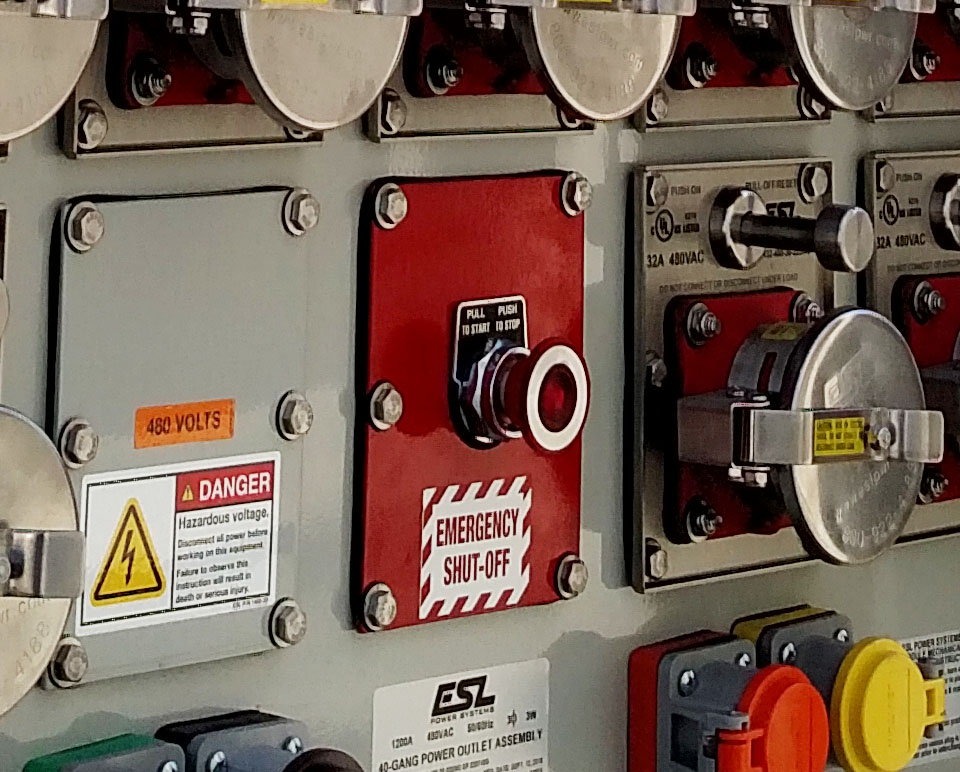 engaged (pushed in)? Pulling them out may start the generator. Ensure that no one is working on the generator or is inside the container enclosure before pulling out any emergency stop button. There are two E-Stop buttons - one located outside the main door and another inside near the control panel.
engaged (pushed in)? Pulling them out may start the generator. Ensure that no one is working on the generator or is inside the container enclosure before pulling out any emergency stop button. There are two E-Stop buttons - one located outside the main door and another inside near the control panel. - Is there fuel in the tank?
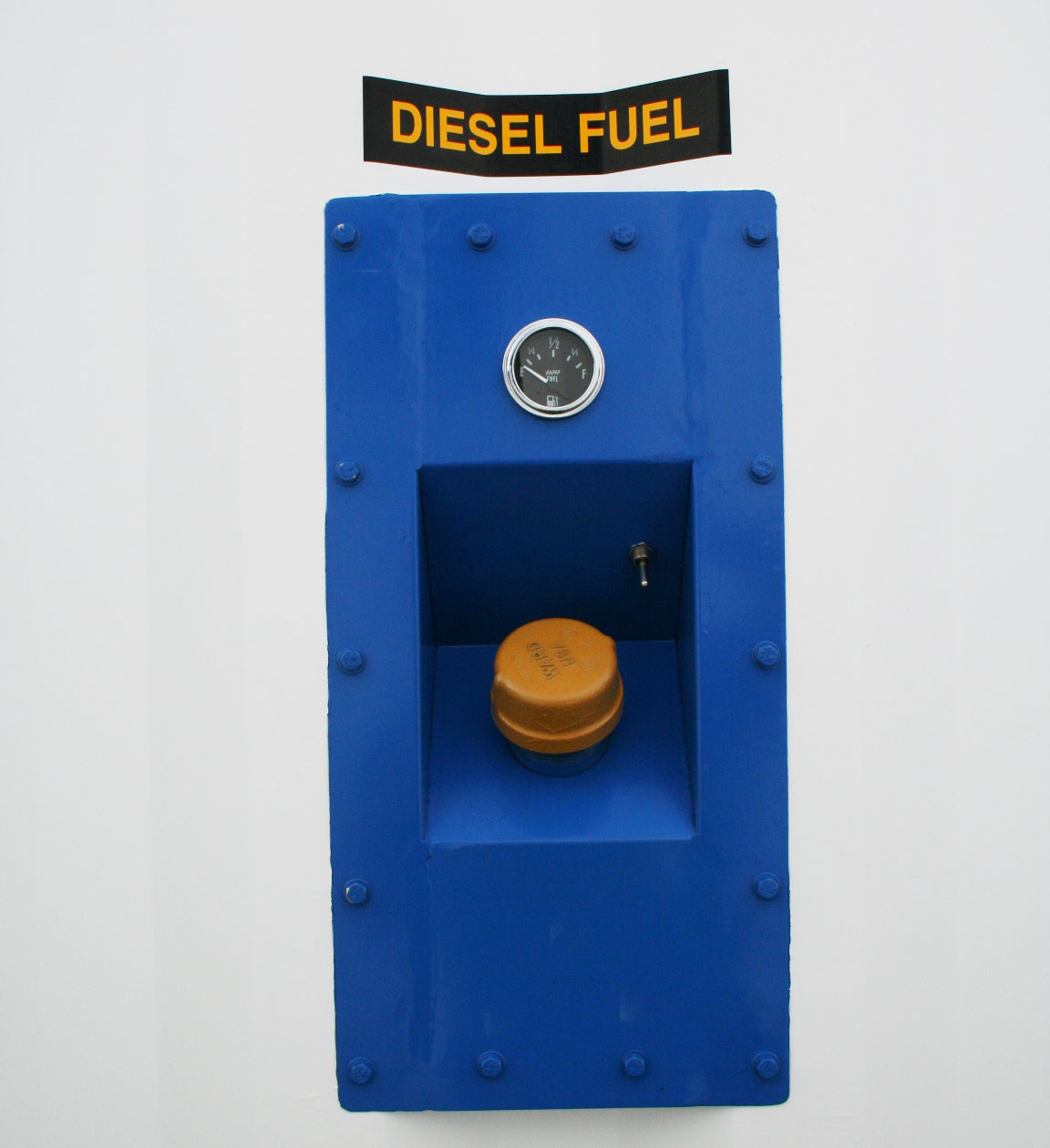 Yes, it may seem obvious, but our road service team has been called out many times only to discover a power pack that was allowed to run out of fuel. Note: after refueling, prime all fuel filters with fuel before restarting the engine. This will ensure a quick start and protect the fuel pump from damage.
Yes, it may seem obvious, but our road service team has been called out many times only to discover a power pack that was allowed to run out of fuel. Note: after refueling, prime all fuel filters with fuel before restarting the engine. This will ensure a quick start and protect the fuel pump from damage.
Power Pack shuts down without warning
- Fuel issues are the leading cause of power pack failures in ports. Poor fuel quality means clogged fuel filters. Change fuel
 canisters and elements, and drain and clean fuel/water separators frequently. Prime all fuel filters.
canisters and elements, and drain and clean fuel/water separators frequently. Prime all fuel filters. - Overloading power packs is a common problem, and can easily lead to generator shut down and loss of the connected load. It happens when the
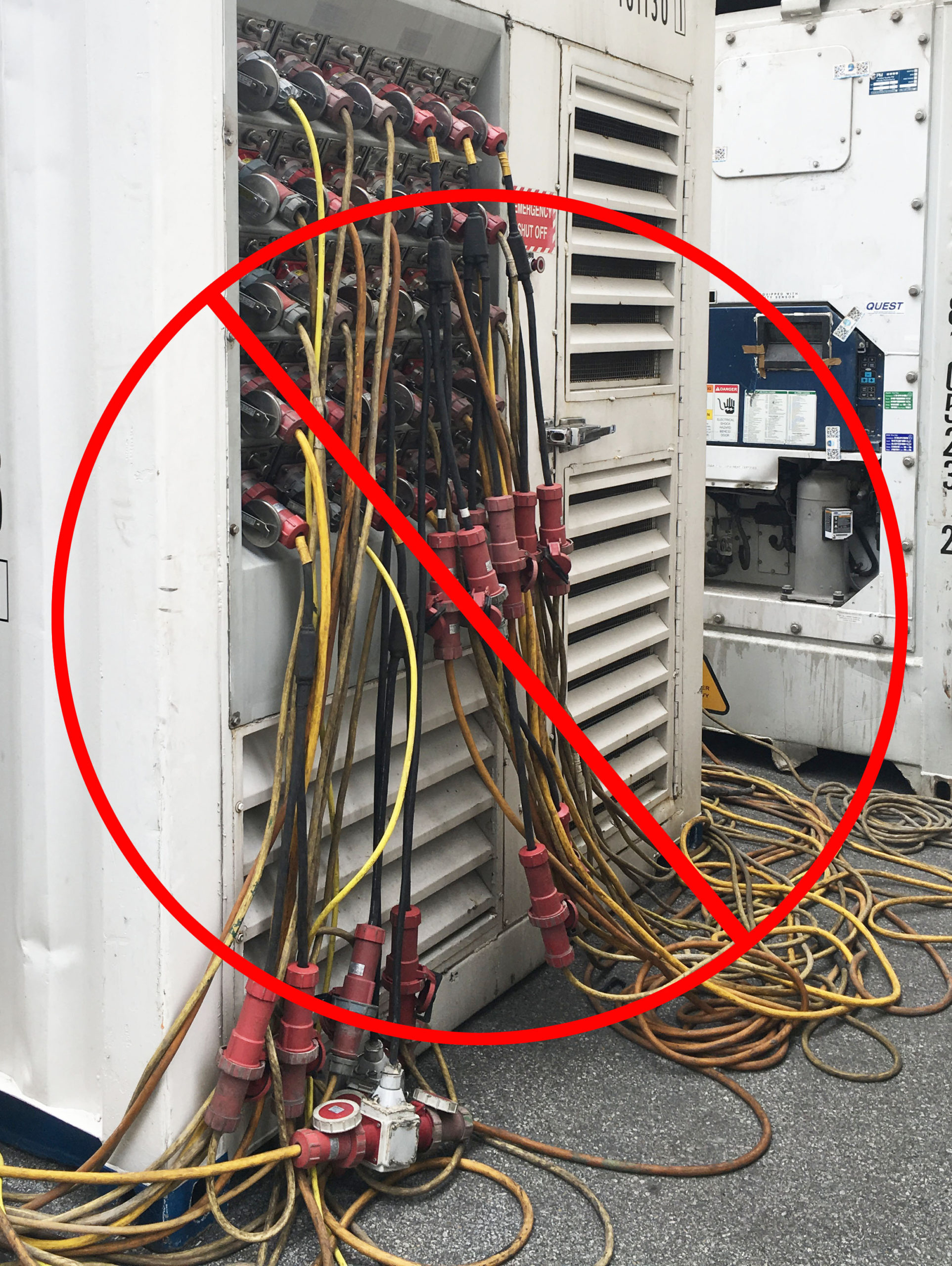 reefer operator has more refrigerated containers to keep powered than available receptacles on the power pack. Beware of commonly used splitters to add capacity to power pack receptacle panels. An over-zealous operator may be inclined to connect as many as double the rated capacity of the power pack. It won’t take long to exceed the limitations of the power pack causing the main breaker to trip and cutting electrical current from the generator to the plugs.
reefer operator has more refrigerated containers to keep powered than available receptacles on the power pack. Beware of commonly used splitters to add capacity to power pack receptacle panels. An over-zealous operator may be inclined to connect as many as double the rated capacity of the power pack. It won’t take long to exceed the limitations of the power pack causing the main breaker to trip and cutting electrical current from the generator to the plugs. - Low oil level, low coolant level, and other alarm faults can cause your power pack to shut down to protect itself from damage. Before each startup, or at regular intervals during 24hr run cycles, visually inspect for leaks and worn parts, check and top off all fluids to proper levels, adjust loose belts or replace as necessary, and remove debris from the container compartment.
Power Pack runs but does not produce electrical power

- Check that the main breaker is engaged. Every power pack is different, but commonly located near the main control panel. Best practice is to engage the main breaker AFTER starting the engine.
Power Pack produces black exhaust smoke when running
- Black exhaust smoke is a common sign of wet-stacking caused by under-loading a generator. Power Packs come in many sizes,
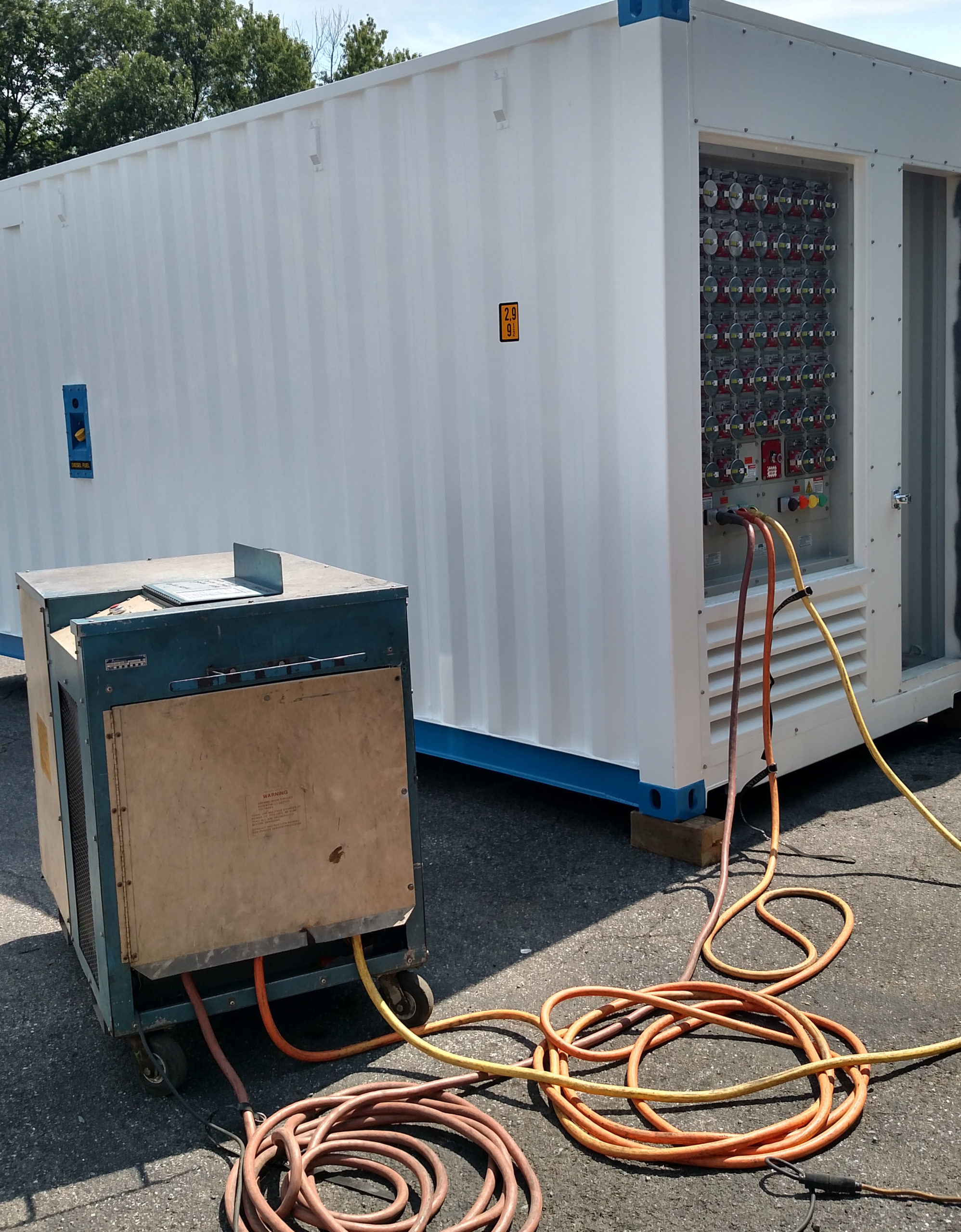 typically identified by plug count (20-plug, 30-plug, 40-plug, and so on). They can carry a load equal to that number of refrigerated containers. Connecting less than half that amount over long periods is equivalent to starting your car and letting it run idle all day long, which is not ideal for the vehicle. A diesel engine will create soot, or unburnt fuel when operated like this. Too much of this carbon buildup will rob the diesel engine of vital power. Loading up the power pack to its capacity should clear most black smoke issues. If not, a load bank may be needed to replicate or add additional load to the power pack. Power Pool Plus can assist in this.
typically identified by plug count (20-plug, 30-plug, 40-plug, and so on). They can carry a load equal to that number of refrigerated containers. Connecting less than half that amount over long periods is equivalent to starting your car and letting it run idle all day long, which is not ideal for the vehicle. A diesel engine will create soot, or unburnt fuel when operated like this. Too much of this carbon buildup will rob the diesel engine of vital power. Loading up the power pack to its capacity should clear most black smoke issues. If not, a load bank may be needed to replicate or add additional load to the power pack. Power Pool Plus can assist in this.
Final Thought:
Power Packs are essential equipment for nearly every reefer operator. Setting aside even a small amount of time to understand a few of these concerns and how to address them quickly will go a long way in protecting your power pack and the valuable refrigerated load connected to it.
Questions? Contact Us.
The Power Pool Plus Service Team is available anytime to help keep your power pack reefer gensets running at their best, day or night.
Ted Shelson
VP Marketing
Power Pool Plus
Is your fuel killing your power pack? How to mitigate fuel quality issues.
Bad fuel kills power packs. Don't allow poor fuel quality to affect power pack performance.
Poor fuel quality is the number one cause for power pack failure and engine shutdown. Contaminated fuel in storage tanks can create particulate that becomes suspended in the fuel during power pack transportation, movement, or refueling. This particulate restricts fuel flow by clogging fuel filtration systems.
Fuel related issues can be more than an inconvenience. Clogged filters can damage expensive fuel pumps and injectors, not to mention the downtime associated with these repairs.
How does fuel contamination happen?
Many outside elements can affect fuel quality, either by the introduction of debris or through the degradation of the fuel itself. Here are some common challenges that power 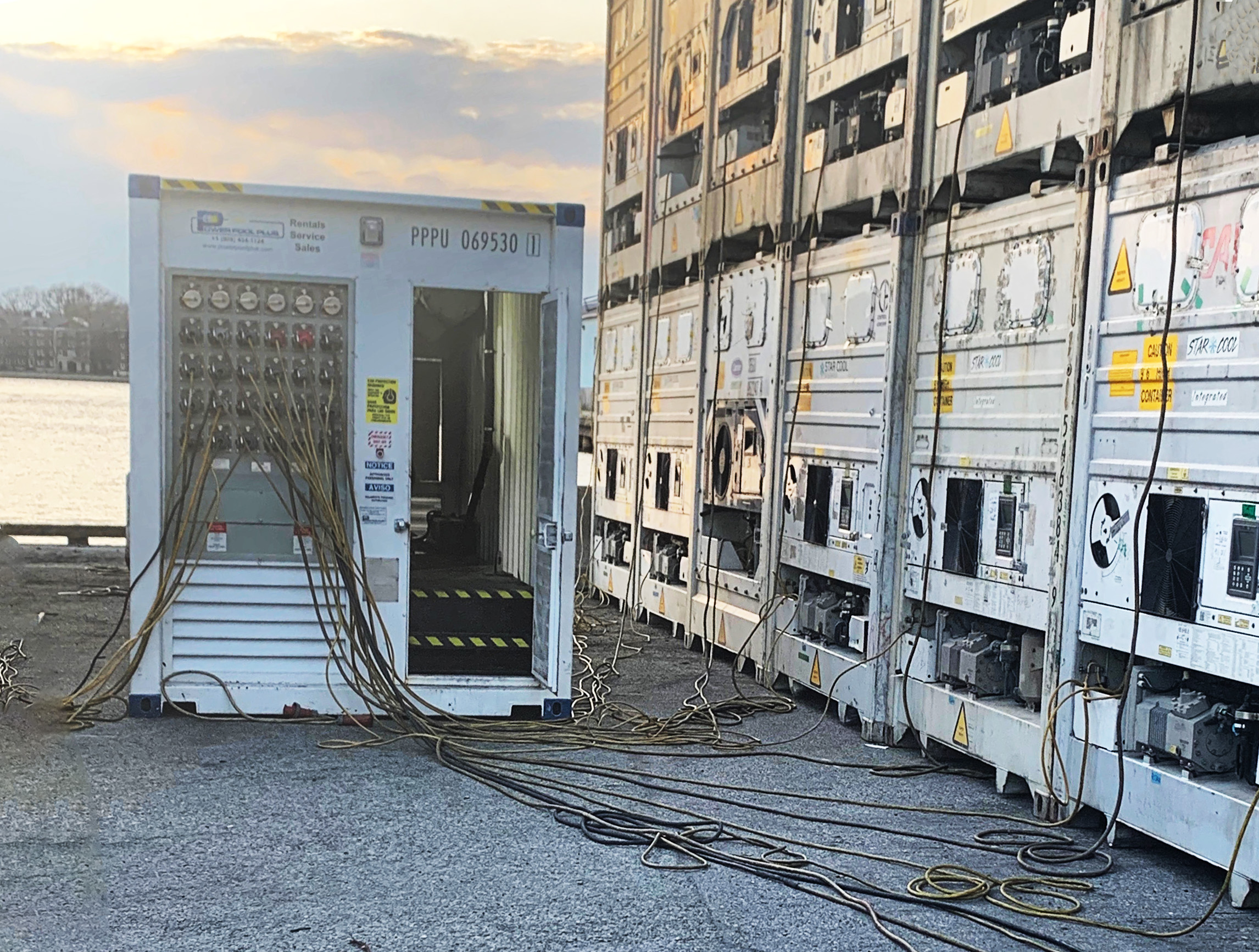 pack operators face:
pack operators face:
Water
- Reefer yards located near open water, face an unavoidable challenge. Temperature changes create condensation, humidity enters through ventilation ports, and the refueling process allows for the introduction of water.
- Water promotes bacterial growth creating one of the more common contaminants; micro-organisms, called diesel bugs, live and die in the fuel forming debris.
- Rust particulate and corrosion on critical engine fuel system components are a result of water in fuel tanks.
Hard Particles
- Windblown sand and dust are common problems in many reefer yards. Often these contaminants enter the fuel tank during refueling.
Soft contaminant particles
- Overheated and degraded diesel fuel enters the tank through the return line. These particles act like gum and coat filters with a black asphaltene-like substance, leading to power loss and engine shutdown.
These are just a few ways that fuel contamination occurs. Understanding these challenges and taking preventative action where possible are the first lines of defense.
Here's what we're doing about it.
We equip all Power Pool Plus rental power packs with a primary fuel filtration system as the first step in removing contaminants.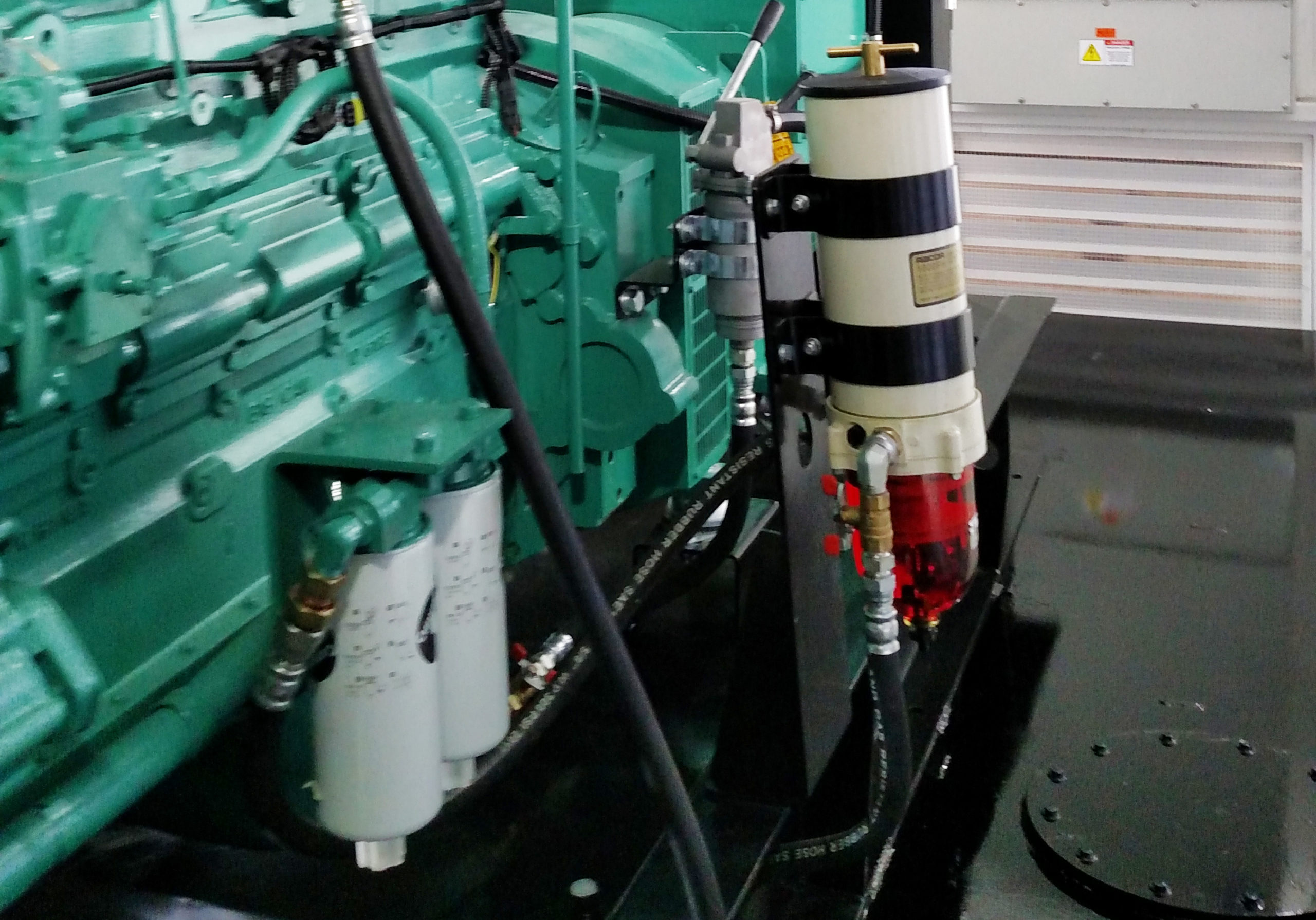
During routine power pack inspections, take note of the filtration system located upstream from the standard fuel filters. Empty the water collection bowl and replace the filtration element as needed.
Doing this simple process will:
- Prevent costly injector damage.
- Increase the operational life of downstream filters
- Save time and money by eliminating unplanned maintenance and unscheduled downtime from fuel system component failure.
A best practice is to keep several extra fuel filters and cartridges on-hand and replace them at the first signs that the engine is starving for fuel.
Ensuring the quality of the fuel is the responsibility of the power pack operator. Don't allow poor fuel quality to affect the performance of your power pack; the critical load of reefer containers under your care is counting on it.
Ted Shelson
VP Marketing
Power Pool Plus
It's all about the cold chain
The need for perishable goods has never been greater. Keeping the cold-chain intact is critical not only to end-users of our reefer generators but to our entire community at large.
Like most companies, Power Pool Plus is doing our best to keep our team safe and healthy amid #COVID19 concerns by maintaining social distancing whenever possible, limiting access into our facility, and allowing those who can work from home to do so.
Please note that our operation remains open and continues to work hard filling orders for both new and re-manufactured Power Packs. Our service team is on-call and ready to serve.
We would like to extend a special thank you to our customers, many of whom are the port operators working on the front lines in areas hardest hit by the corona-virus outbreak.
And thank you to our many vendors that continue to operate and supply us with the raw materials needed to produce quality Power Packs that reefer operators have come to expect from Power Pool Plus.
Having quality fresh food on our shelves will help make the challenges of getting through this crisis just a little more bearable. Together we can all do our part to keep fresh produce moving.
We are here when you need us.
Power Packs, Mobile PortaPacks™, Service, Rentals
5 Ways to Protect Your Power Pack During Emergencies
COVID-19 related events are having a profound effect on local grocery store inventory. The resilience of the supply chain will have a significant impact on the health and welfare of all of us.
Even those that until now may not have fully understood the role that we in the refrigerated transportation industry play in keeping fresh produce on the shelves, they are indeed watching us now.
One key element is the Power Pack reefer generator to ensuring the successful throughput of the perishable cargo under your care.
All of us here at Power Pool Plus remain available to assist where possible. Your team, however, is the first line of defense against unexpected generator shutdowns. And the proper maintenance practices that you follow may make the difference between success and failure.
Here are some fundamental steps that everyone on your team should know in regards to Power Pack maintenance.
- Keep extra fuel filters on hand - Bad fuel is the #1 cause for generator failure. Checking for clogged fuel filters is an excellent first action to power pack shut down. Replace each as needed and be sure to correctly prime each filter before installation. If equipped with a RACOR filtration system, visually check for debris and clean as necessary.
- Avoid low reefer count per Power Pack - In other words, try to limit the times that each power pack is under-loaded, or under 50% capacity. Under-loaded Power Packs will cause a condition known as wet-stacking, indicated by thick black exhaust smoke, which may limit engine performance when you need it most.
- Check Oil Levels Daily - Daily inspection of oil levels, including reserve make-up tanks (if equipped), will prevent surprise shutdowns due to low oil pressure.
- Check Coolant Levels Daily - Change in reefer load quantities from low to high can affect engine operating temps causing some coolant to release from the system. Daily inspection can reduce shutdowns due to low coolant levels.
- Keep up with routine maintenance schedules - The best line of defense against power pack failure is to keep fresh eyes on your machines as frequently as possible. Here are our suggestions:
-
- Every 250 Hours
- Change Oil and Filters
- Change Fuel Filters
- Inspect Belts and Hoses for Wear (Replace as Needed)
- Inspect for Oil and Coolant Leaks
- Address any concerns ASAP or contact Power Pool Plus
- Every 500 Hours
- Same as above PLUS change Air Filters
- Inspect radiator for dust and debris build-up. Note: clogged radiators should only be cleaned by professionals with the right equipment and skill to prevent delicate radiator damage.
- Every 250 Hours
These steps are only a few first response actions to keep your power pack generator healthy and operational. If there are other concerns or questions related to power pack maintenance, please contact Power Pool Plus for more details.
How to manage black exhaust smoke
Attention to load will improve power pack performance.
Power packs are the lifeblood of most reefer cargo operations. Keeping them in top shape through regular maintenance is a necessity.
Understanding load and how it affects power pack health is a critical part of this process.
Is your power pack underloaded?
It might seem obvious that overloading a power pack can have negative implications for a generator’s performance. Yet under-loading can be just as serious, if not more problematic to its long term health.
What does it mean to under-load a power pack?
An underloaded power pack is defined when the amount of load (Reefers) is far below the available power (Plugs) that the power pack is equipped to handle.
This situation may be unavoidable from time to time as there may only be limited numbers of refrigerated containers in your yard - as might be the case between shipments. Other times, it is a practice done intentionally under the misconception that this helps prevent the generator from having to work too hard.
The negative effects of under loading (wet-stacking).
Professionally built Power Packs are designed to precise specifications based upon the amount of load (or electricity) they are demanded to produce. Anything short of that, and the generator is not operating to its fullest potential. They will use more fuel, burn oil, and wet stack (produce black smoke) – issues that in time will lead to a shorter equipment life expectancy and sudden failure.
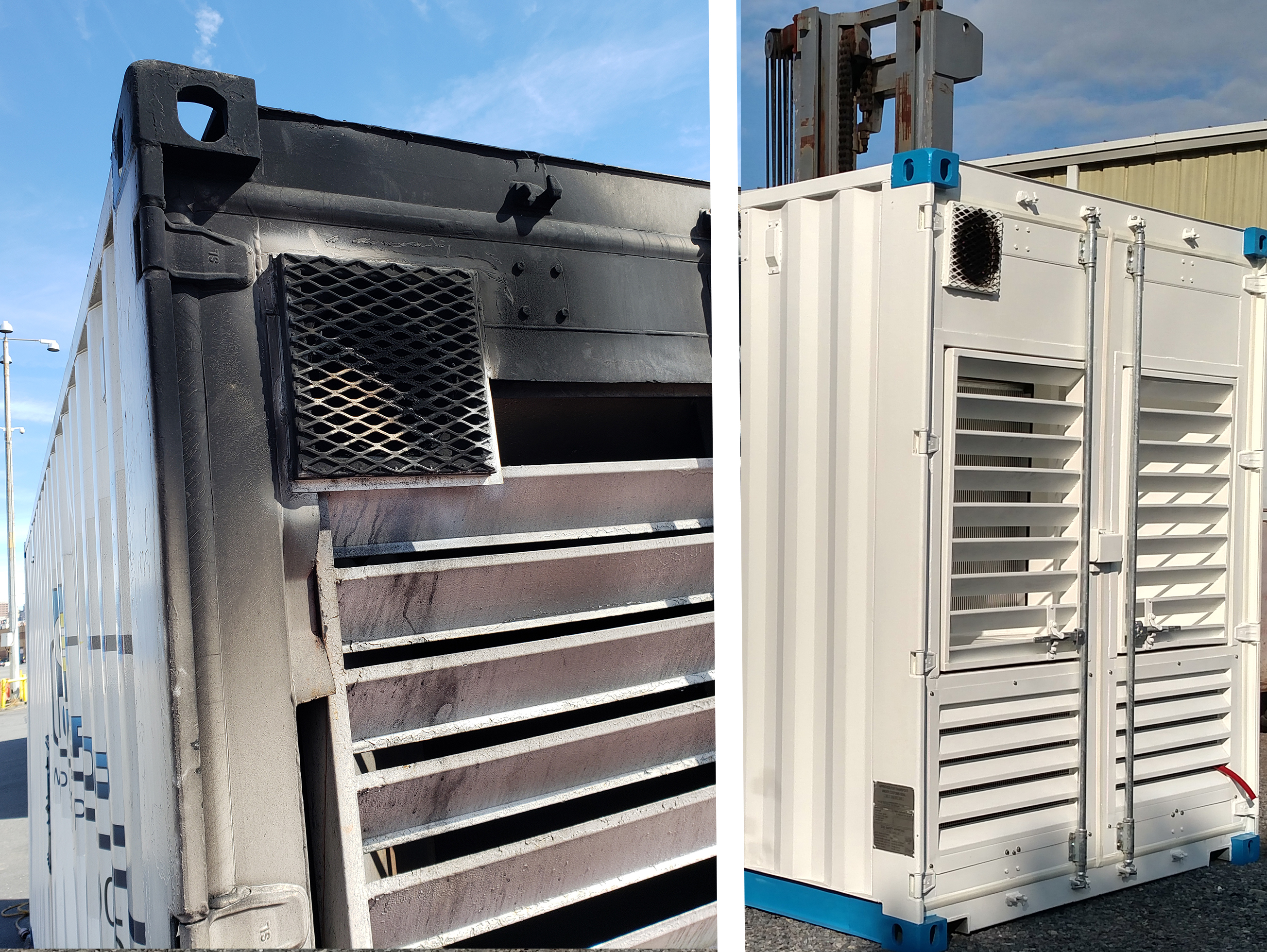
If you are experiencing black exhaust smoke issues, a rather common occurrence called wet-stacking is likely due to the power pack's lack of load.
Solution
To correct this situation, avoid running them on less than the optimal load for long periods of time. We understand that this may not always be practical given the number of reefers available. However, diesel-powered generators perform best when they are fully loaded up with reefer plugs. So be sure to manage them to full capacity periodically or consistently maintain them at an optimal load per generator.
What is the optimal load?
The number of actual reefers needed to obtain optimal load will vary from one size power pack to another. As a general rule of thumb, it is recommended to maintain a minimum of 70% capacity to reach the point at which the generator is working efficiently enough to burn cleanly and avoid maintenance concerns like wet-stacking (Black Exhaust Smoke).
As an example, the optimal load on a 40 plug power pack should be around 28 reefers. This is provided, of course, that the 40 plug power pack is built to proper specification.
* Care should be taken for hot boxes being brought down to temp not to overload the unit. Always follow the manufacturer's recommended operating instructions.
Conclusion
When possible, load up your Power Packs and let them run. Do this, and your black exhaust smoke issues will go away. But if problems persist, it could be signs of a bigger concern. Contact Power Pool Plus for further direction to help resolve.
Have other Power Pack performance questions? Contact us today.
Y-Splitters - Are they good or bad?
When you have more reefers in your yard than plugs available on your Power Pack, it might be tempting to use electrical Y-splitters on your reefer extension cords to increase capacity. But here’s why this practice should be avoided, if possible.
As the demand for fresh produce grows globally, shipping companies have been keeping pace by ordering new reefer containers by the thousands. These latest reefer designs are far more efficient and consume less energy than previous models. So conventional wisdom might suggest that Power Pack diesel generators can handle more reefer containers. Using Y-splitters is an easy way to do this.
What are Y-Splitters?
Designed for temporary use to meet short-term demand spikes, Y-Splitters allow multiple reefer cords to connect to a single power source receptacle.
Caution is advised
While adding more connections than a power pack is designed for may provide a temporary and safe solution when connected to newer low-current reefer boxes, caution should be exercised as it is possible to exceed the specifications of the power pack.
Many container fleets still have a big share of older reefer versions in use today. These, of course, draw a much higher current than the newer designs. When reefer yard technicians cannot control the age of the reefer containers that reach their yard, the risk of overloading power packs increases.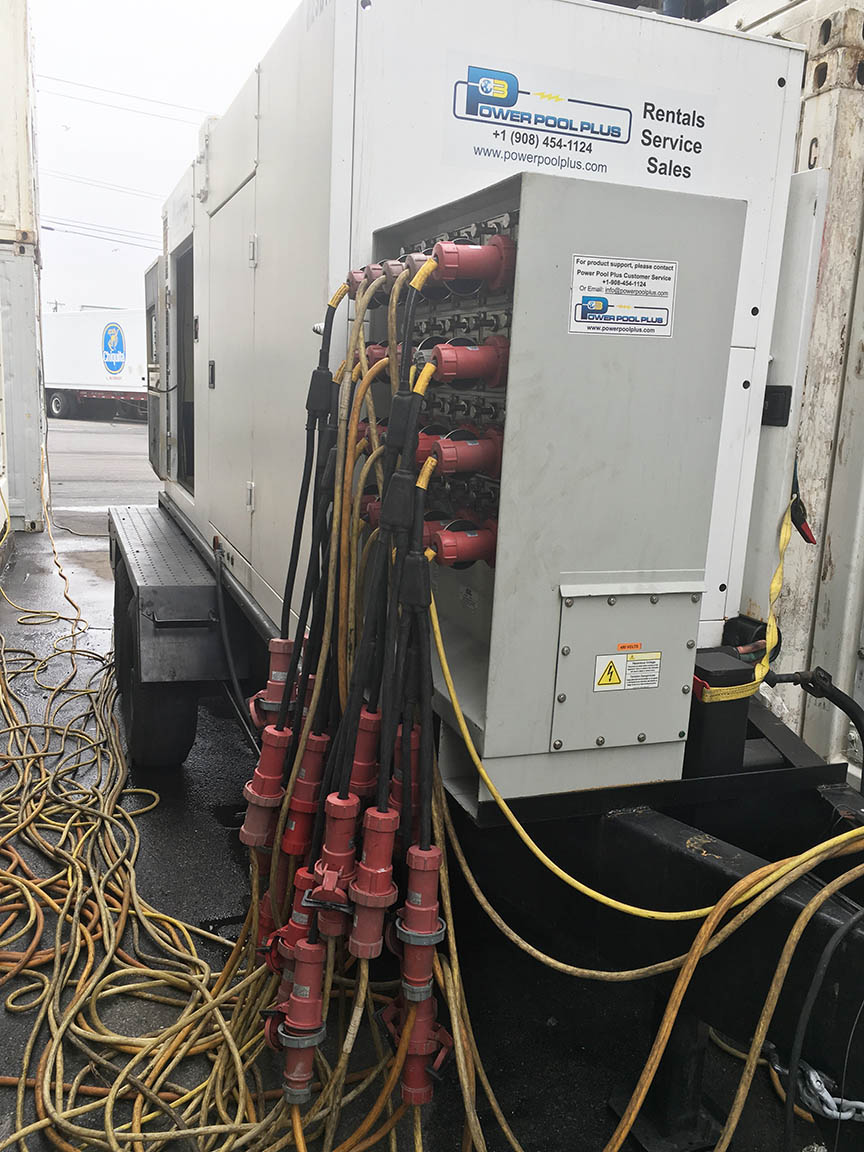
Hot Reefer Boxes
And what if several of the reefer boxes are hot when connected using Y-splitters? When these boxes all come online at once, it’s quite possible that the current draw will exceed the limitations of the power source. With loads of perishable cargo under your care is it really worth the risk of damaging your power pack and losing the valuable cargo entirely
Safety
Then there is the safety aspect. Y-splitters when improperly handled can bypass the integrated safety designs of the receptacle panel. The safety of personnel is paramount. ESL Power Systems, manufacturers of reefer and intermodal electrical components, recommends the following guidelines when using Y-splitters:
- Do not connect or disconnect reefer plugs to a splitter while energized
- Reefer plugs must be connected to the splitters female cord connectors before connecting the male plug to an interlocked outlet
- Use of multiple Y-splitters on the same circuit is not recommended
- Do not exceed the Y-splitter rated current
Y-splitters can be an effective tool for meeting short term, high volume throughput of reefer cargo. Use them with caution while understanding all the variables involved. And if more plugs are needed to meet short or long term refrigerated container demands, increase your capacity safely with additional power packs or portapacks from Power Pool Plus.
For questions on how to properly apply refrigerated container load to your power packs, contact Power Pool Plus.
Ted Shelson, VP Marketing
Power Pool Plus
How load affects Power Pack performance
Proper Loading of Power Pack Reefer Generators
Are your reefer loading processes harming your power packs?
In a recent survey we asked the question, ‘What is your typical practice for connecting reefer plugs to your power pack?’ Possible choices included:
- We fill the receptacle panel then start the power pack.
- We connect one at a time while the power pack is running.
- We connect them in groups of 5 or more at a time.
While the number of responses varied between the choices, a significant number selected choice #1, indicating that loading the power pack’s receptacle panel with connections prior to generator start is the preferred choice.
It’s easy to understand, perishable cargo tends to move in large quantities. And with many reefers hitting the docks at any one time, the goal, of course, is to quickly get these refrigerated containers connected to power. But take a moment to consider that this technique may have the potential to cause damage to your equipment which could potentially render your cargo without any electrical power.
Why this is bad.
Loading too many reefer boxes at one time on a power pack can cause the engine to work excessively hard to catch up to the required load. In the meantime, this may result in a drop in generator performance as the engine struggles to maintain sufficient power to meet this sudden demand. The results will be a reduction in hertz or electrical frequency causing potential damage to the generator’s voltage regulator. Loss of frequency can flow downstream to the reefer causing damage to refrigeration compressors. Additionally, there is added stress on the fuel delivery system to maintain engine power.
Either of these scenarios will leave you with a down machine, expensive repairs, and a load of perishable cargo without electrical power to maintain temperature.
How to avoid a problem
A systematic approach to loading Power Packs should be incorporated in order to avoid costly and time delaying damage.
Power Pack Loading Procedure, a Best Practice Approach
Every power pack is different and may have varying engine and generator configurations. It is strongly advised to review and understand all of the manufacturer’s operations manuals prior to beginning any power pack starting procedure.
Once started, here are some guidelines to ensure that you maintain the best performance from your power pack generator.
Applying load
Once power pack is properly started allow the engine to warm up for 5 minutes before loading reefers. Engage Main Breaker to ON Position.
For ESL Power receptacle panels:
- Insert a single reefer plug into the panel and secure locking ring by rotating clockwise
- Depress the plunger to energize receptacle.
- Repeat steps 1 and 2 above for each additional receptacle plug added to the panel.
Continue loading reefers until reaching a load of 50%. At this time, check amperage on the generator control panel. This is important to ensure that your generator is managing the load and working within optimal engine performance. Refer to the specifications of your power pack for total amperage information.
If at 50% capacity total amperage is under the specified maximum amperage of your power pack, then continue to load reefers gradually to full capacity, but continue to monitor the ammeter.
If amperage is OVER the maximum amperage STOP LOADING and wait for refrigerated container compressors to cycle before continuing to load more.
Loading too many reefers, especially hot reefers, at any one time may cause the amperage draw to exceed the limitations of your power pack.
Maximum amperages vary depending on the specifications of your power pack. If you are unclear on the maximum amps for your power pack, contact Power Pool Plus for information. Operating a power pack at near max amp rating should be monitored closely to avoid tripping main circuit breaker and losing all connected reefers.
A special note on loading: At minimum, there should always be at least a load of 25% of total panel capacity. In other words, if operating a 40 plug power pack, minimum load will be 10 reefers or 8 for a 30 plug machine. This will protect your power pack in 2 ways:
- Avoid the damaging effects of wetstacking – thick black exhaust smoke.
- Allow a more efficient use of your power pack. More reefers attached to your power pack means less fuel burn per reefer – which will save you money.
Unexpected shut down while connected to full load of reefers
Should an unexpected engine shut down occur, either through a run-fault event or manual stop, never perform a re-start while connect to a full load of refrigerated containers. Instead, load should be removed from the power pack and brought back on gradually. Best practice would be; de-energize ALL ESL receptacles, ensure that the main breaker is CLOSED, and re-start the power pack. At this time bring reefers back on line following the procedure highlighted above by energizing the ESL receptacles individually until all are successfully back online.
Manually shutting down an operating Power Pack
Often times, out of convenience, bad habits, or simply insufficient operator instruction, emergency stop (E-stop) buttons are routinely used to shut down a running power pack.
Emergency stop buttons should only be used for emergency situations, such as pending harm to personnel or equipment.
Using E-stop buttons as a regular means of power pack shut down can cause damage to the engine and generator components by not allowing a proper disconnection of electrical current to the load and necessary slow cool down of the engine.
Instead, follow this procedure,
- Open main generator circuit breaker
- Allow engine to cool down for 10 minutes
- Press the stop button located on the generator control panel. The generator will then stop. Some power packs have a built in shut down procedure that initiates upon pressing the stop button on the Control Panel. Check your Owner’s manual for specific information on your power pack design characteristics.
In short, unless it is an actual emergency, use the stop button located on the Control Panel and NOT the Emergency Stop buttons.
Wrapping it up
Each Power Pack is different with unique engine kVA and kW output. But the process for loading them to protect the Power Pack from overloading is the same. Following these quick and easy steps will ensure long lasting performance from your reefer power solution.
Power Pack maintenance doesn’t begin and end with oil changes. It starts with proper machine operation. No matter if your operation handles chilled loads, frozen loads, or pre-trips hot reefer boxes, Power Pack performance can be greatly affected by the way in which load is applied. Following these procedures to ensure that you get the most out of your reefer power system.
For more details on power pack operations read: 7 Best Practices for Every Power Pack Operator.
Have questions?
Please contact us today to learn more.

